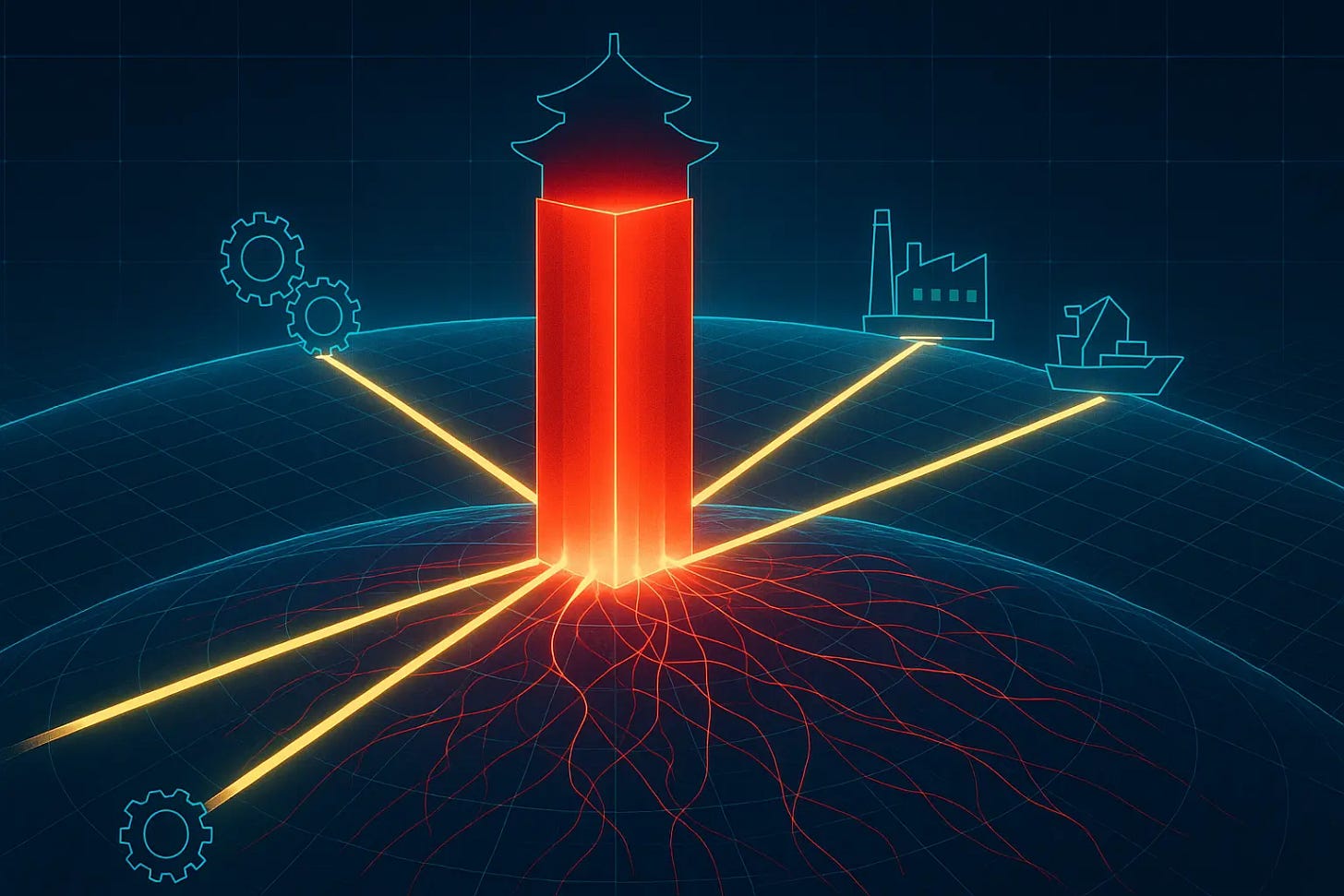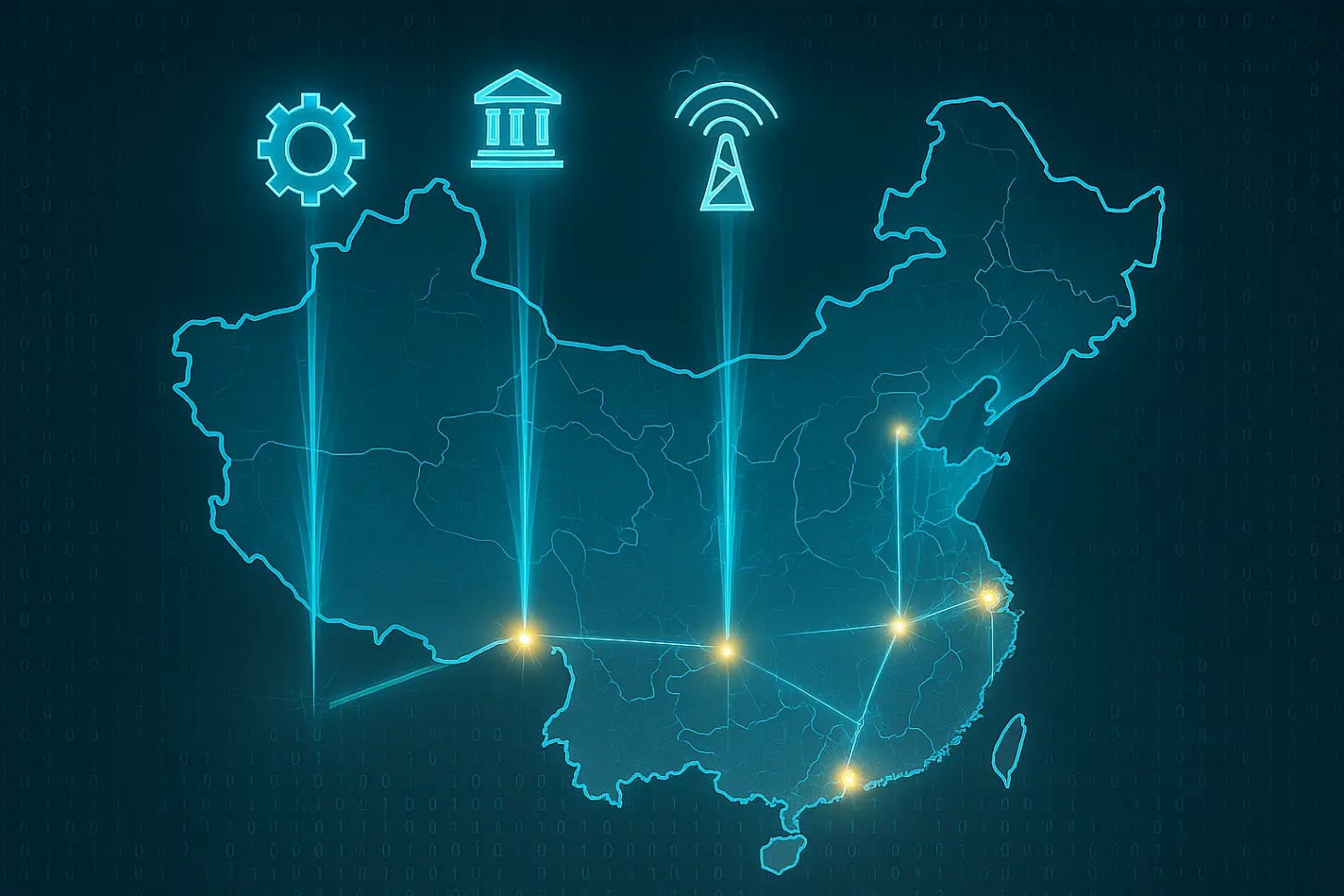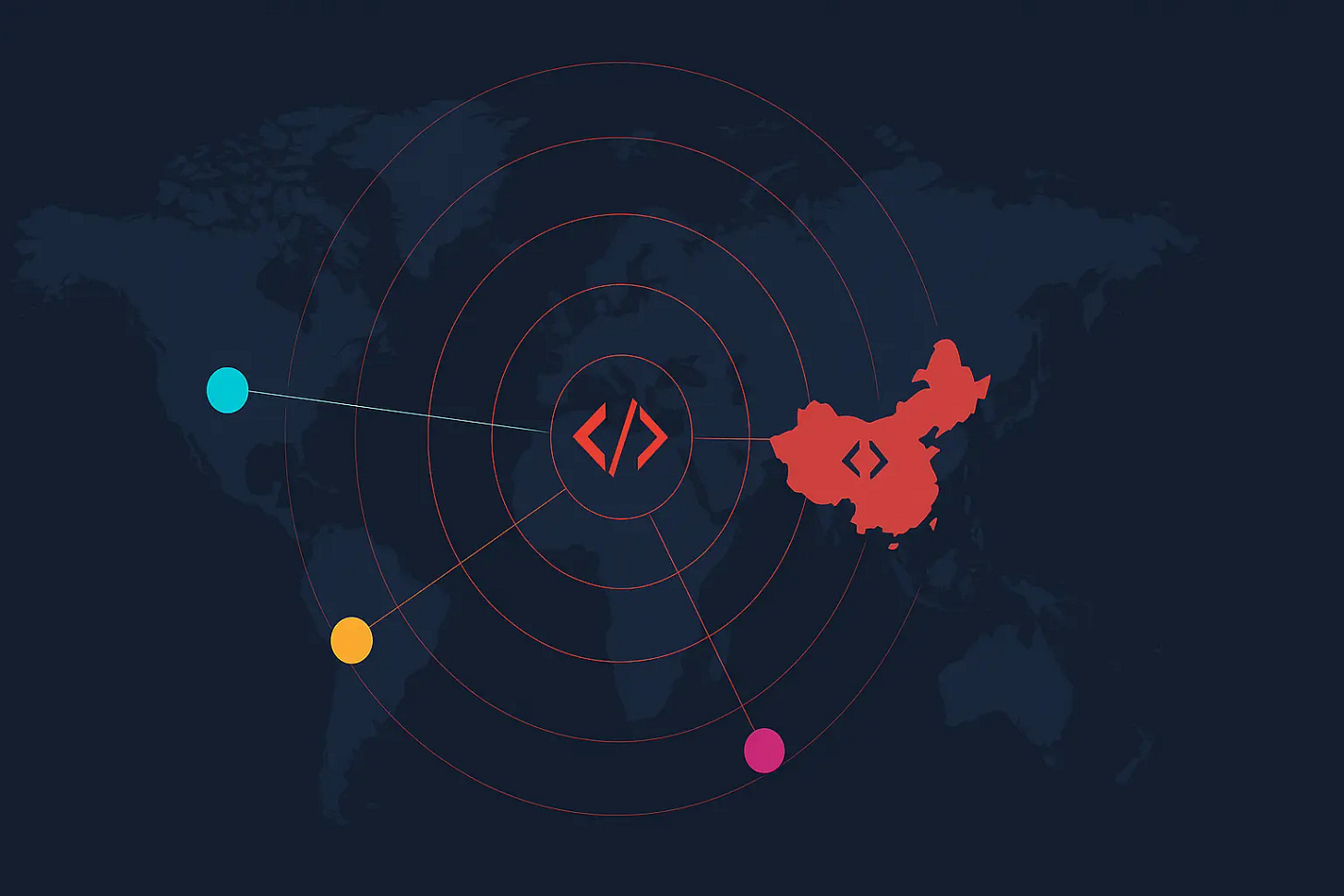China's AI Playbook: How State Power and Open Source Are Forging a New Order
While the West Builds Chatbots, China Is Building an AI-Powered State.
Hello China Tech by Poe Zhao – Weekly insights into China’s tech revolution. I analyze how developments in Chinese AI, electric vehicles, robotics, and semiconductors are reshaping global technology landscapes. Each piece contextualizes China’s innovations within worldwide market dynamics and strategic implications.
For most of the world, the AI evolution is tracked through public-facing developments–new model releases, benchmark scores, and viral applications. But some of the most significant strategic shifts occur away from the public eye.
While the tech world speculates on GPT-5, a notable trend is underway within China’s state-controlled industrial sectors. It’s a development measured less in chatbot capabilities and more in the integration of AI into power grids, factory floors, and financial systems. This reflects a strategic effort to apply AI as a tool for industrial upgrading, and this quiet deployment warrants closer examination.
The story isn’t just about which model is incrementally better at a specific benchmark; it’s about where this powerful technology is actually being put to work. Chinese open-source model DeepSeek has gained significant attention this year, rivaling top global models on leaderboards. But beyond the hype, a crucial question arises: what does its real-world adoption look like? An under-the-radar tally from Chinese media outlet Sohu provides a startling answer:
“据不完全盘点,央企有60家完成部署,地方国企涵盖北京、上海、天津、重庆四大直辖市的40多家企业…涉及众多不同层级和领域的企业单位。” (According to an incomplete tally, 60 central state-owned enterprises (SOEs) and over 40 local SOEs across the four major municipalities of Beijing, Shanghai, Tianjin, and Chongqing have completed deployment… involving enterprise units at many different levels and in various fields.)
In total, the report details the deployment of a single Chinese open-source model, DeepSeek, in at least 113 state-owned enterprises.
This isn’t a pilot program. This appears to be a coordinated, top-down integration of advanced AI into the country’s most critical sectors–from energy and finance to telecommunications and manufacturing. It signals a strategic pivot from merely competing on model performance to leveraging AI as a tool of national industrial policy. For global investors, executives, and policymakers, understanding this state-driven adoption model is now more critical than tracking the latest chatbot release. It reveals a playbook that could influence the next phase of global AI competition.
State-Driven Adoption at a Notable Scale
The Western narrative of AI development is largely a story of market-driven, consumer-facing competition. In China, a parallel, state-orchestrated narrative is taking shape. The deployment of models like DeepSeek across China’s SOE landscape is not just about improving efficiency; it’s about creating a vast, protected domestic market and a real-world training ground for its national AI champions.
The scale and scope are extensive. Consider the entities involved, as detailed by Sohu:
Energy: State Grid, China National Petroleum Corporation (CNPC), and China National Offshore Oil Corporation (CNOOC) are using DeepSeek to optimize energy dispatch, manage equipment, and predict risks.
Finance: Banks like Pudong Development Bank and brokers like Haitong Securities are deploying the model for everything from risk management to customer service.
Telecommunications: All three of China’s telecom giants–China Mobile, China Telecom, and China Unicom–have integrated DeepSeek into their cloud platforms.
Manufacturing: Automotive giants like SAIC Motor and FAW Group are embedding the model into their smart cockpit systems.
A crucial detail, often lost in translation, is the emphasis on sīyǒuhuà bùshǔ (私有化部署), or “private, on-premise deployment.” This means the models are running on internal, air-gapped servers, not on a public cloud.
Why This Matters: For these SOEs, which control the lifelines of the Chinese economy, data sovereignty is non-negotiable. This deployment model ensures that sensitive industrial, financial, and state data never leaves their control. For global tech firms, this presents a formidable barrier to entry. It’s not enough to offer a superior API; competitors must be willing and able to support complex, secure, on-premise installations within China’s unique regulatory environment. This state-led adoption creates a powerful moat for domestic AI firms, guaranteeing them a massive, foundational client base that is largely inaccessible to foreign players.
Developing Advanced Capabilities: A Focus on Agents and Engineering
This rapid, large-scale deployment would be less significant if the underlying technology were second-rate. But Chinese open-source models are no longer just catching up; in key areas, they are demonstrating competitive performance. This progress is not based on simply scaling up parameters but on targeted developments in practical, high-value capabilities and the sophisticated engineering required to achieve them.
A key area of focus is “Agentic AI”–the ability of a model to autonomously use tools, write code, and execute complex, multi-step tasks. This is where models transition from being conversational partners to productive workers. And here, the benchmarks are telling.
According to VentureBeat, Moonshot AI’s Kimi K2 achieved 53.7% accuracy on LiveCodeBench, a realistic coding benchmark, decisively beating both DeepSeek-V3 (46.9%) and GPT-4.1 (44.7%). Alibaba’s Qwen3-Coderscored 67.0% on the SWE-bench, putting it on par with top-tier closed models like Claude Sonnet-4.
This focus on agentic capabilities appears to be a deliberate strategic choice. Chinese tech media outlet 36Kr captured the philosophy of Moonshot AI’s founder, Yang Zhilin, perfectly:
“我们就把 200 万字上下文列为第一优先级,而不是去卷通用榜单。” (We made the 2-million-character context window our top priority, instead of just competing on general leaderboards.)
Why This Matters: This “long-context” strategy is foundational for agentic AI. A model that can process an entire codebase or a year’s worth of financial reports in a single pass can perform tasks that are impossible for models with shorter attention spans. This focus on practical, workflow-oriented capabilities over conversational prowess reveals a different product philosophy–one aimed squarely at enterprise automation.
Underpinning these advances are notable engineering efforts. VentureBeat highlighted Moonshot AI’s development of the MuonClip optimizer, a novel technique that allowed them to train their trillion-parameter model with “zero training instability.” This addresses a massive, costly problem that plagues AI labs worldwide. It’s a sign that Chinese firms are not just implementing existing techniques but are innovating at the fundamental level of AI development.
Open-Source as a Competitive Strategy
Perhaps one of the most important aspects of China’s AI strategy is its embrace of “open source” (or more accurately, open weights). In the West, this is often viewed through a lens of community collaboration. In the context of China’s national strategy, it also functions as a tool for market influence and disruption.
By open-sourcing their powerful models, firms like Alibaba, DeepSeek, and Moonshot AI are executing a multi-pronged strategy:
Rapid Ecosystem Building: They are seeding a global developer community that builds on, improves, and becomes dependent on their architecture. As Chinese media outlet QbitAInotes, Alibaba’s Qwen has already become the world’s largest open-source model family with over 140,000 derivative models, surpassing Meta’s Llama.
Challenging Incumbent Business Models: The strategy, as analyzed by VentureBeat, is a classic “innovator’s dilemma” for closed-source leaders like OpenAI. By offering a free, self-hostable model that is nearly as good as the paid alternative, they force incumbents to either slash prices (compressing their margins) or risk losing customers who prioritize cost and control.
Expanding Global Reach: This strategy is winning allies and users worldwide. DeepSeek now commands 24% of the market share on OpenRouter, a global marketplace for AI models. The praise is not just from niche developers. As the South China Morning Post reported:
Nvidia CEO Jensen Huang has praised China’s progress in open-source AI and expressed a commitment to collaborate with Chinese companies… Huang described LLMs developed by Chinese firms… as “world-class” and vital for global AI advancements.
Why This Matters: For investors, this means the competitive landscape is no longer a simple two-way race between Google and OpenAI. A powerful third bloc is emerging, one that uses open-source as a lever to rapidly gain market share and establish new technical standards. For multinational corporations, it presents both a threat and an opportunity. While reliance on Chinese-led ecosystems carries geopolitical risk, it also offers a potent, low-cost alternative to vendor lock-in with American tech giants.
Conclusion: A New Playbook for a New Era
The emergence of China’s AI players is more than just a story of technological catch-up. It is the story of a different development model–one where state-led industrial policy, targeted technological developments, and a sophisticated open-source strategy converge to create a significant competitive factor.
The focus of global analysis must now shift. Obsessing over whether GPT-5 will score a few points higher than Kimi K2 on a given benchmark misses the larger picture. The more important questions are: What is the real-world ROI of the 113 SOE deployments? How quickly can this state-driven success translate into adoption within China’s vibrant private sector? And how resilient will this new ecosystem be when faced with both geopolitical headwinds and the next wave of innovation from Silicon Valley?
The impending launch of GPT-5 in August, as reported by The Verge, will undoubtedly be a major event. But its success will be measured not just by its own capabilities, but by how effectively it can compete in a world where the rules of the game are being rewritten. China is no longer just playing the game; it is presenting the world with a whole new playbook.
About Hello China Tech
I’m Poe Zhao, and I bridge the gap between China’s rapidly evolving tech ecosystem and the global community. Through Hello China Tech, I provide twice-weekly analysis that goes beyond headlines to examine the strategic implications of China’s technological advancement.
Found this useful?
→ Share this newsletter with colleagues who need to understand China’s tech impact
→ Subscribe for free to receive every analysis:
→ Follow the conversation on 𝕏 for daily updates and additional insights
Get in touch: Have questions about China’s tech sector or suggestions for future analysis? Reply to this email – I read every message.






